This article needs additional citations for verification .(December 2014) |

Jean-Baptiste Paulin Guérin (25 March 1783, in Toulon – 19 January 1855, in Paris) was a French portrait and history painter.
This article needs additional citations for verification .(December 2014) |

Jean-Baptiste Paulin Guérin (25 March 1783, in Toulon – 19 January 1855, in Paris) was a French portrait and history painter.
He was born into a working-class family that moved to Marseille when his father acquired a locksmithing business there in 1794. During his apprenticeship in that trade, he also studied drawing at a local school and displayed some talent for it. [1] Soon, he was spending all of his free time painting. During this time he befriended another aspiring painter, Augustin Aubert, who he joined in Paris in 1802, financing the trip by selling works to a local Baron who was an amateur art enthusiast. After that point, he devoted himself exclusively to painting.

For a short time, he was employed as an assistant to François Gérard while serving as an unpaid apprentice in the studios of François-André Vincent. [1] In Gérard's studio, he prepared the canvases by painting clothing, drapery and miscellaneous items. Most of his earnings were sent home to help support his family. After a time, he became bored with such tedious work and, in 1810, submitted some of his paintings to the Salon where they were generally well received.
Vivant Denon asked him to help decorate the ceiling at the Tuileries Palace, but the project was never finished due to the Bourbon Restoration. After that, he helped to renovate the Palace of Versailles and restore the paintings there. [1] In 1817, he won a gold medal for "Jésus mort et la Mère des douleurs" (Jesus who Died and the Mother of Sorrows), created for the Baltimore Basilica, the oldest major Catholic structure in the United States.

In 1822 his tableau "Anchise et Vénus" attracted the attention of King Louis XVIII, which earned him the Légion d'honneur and, two years later, the honor of painting the King's portrait. In 1828, he was appointed the Director of drawing and painting at the Maison d'éducation de la Légion d'honneur. He also gave private lessons. During the reign of King Louis Philippe, he continued to receive numerous public commissions.
A few months after his death, a major exhibition of his paintings was given at the Exposition Universelle (1855). Some of his works have been mistakenly attributed to Pierre-Narcisse Guérin or Jean-Urbain Guérin, and vice versa. Neither of them were related to him.

Anne-Louis Girodet de Roussy-Trioson, also known as Anne-Louis Girodet-Trioson or simply Girodet, was a French painter and pupil of Jacques-Louis David, who participated in the early Romantic movement by including elements of eroticism in his paintings. Girodet is remembered for his precise and clear style and for his paintings of members of the Napoleonic family.

Adolphe Joseph Thomas Monticelli was a French painter of the generation preceding the Impressionists.

Jean-Marc Nattier was a French painter. He was born in Paris, the second son of Marc Nattier (1642–1705), a portrait painter, and of Marie Courtois (1655–1703), a miniaturist. He is noted for his portraits of the ladies of King Louis XV's court in classical mythological attire.

Carle or Charles-André van Loo was a French painter, son of the painter Louis-Abraham van Loo, a younger brother of Jean-Baptiste van Loo and grandson of Jacob van Loo. He was the most famous member of a successful dynasty of painters of Dutch origin. His oeuvre includes every category: religion, history painting, mythology, portraiture, allegory, and genre scenes.

Adam Frans van der Meulen or Adam-François van der Meulen was a Flemish painter and draughtsman who was particularly known for his scenes of military campaigns and conquests. Van der Meulen also painted portraits, hunting scenes, paintings of chateaux and landscapes. He created designs for prints and cartoons for tapestries.
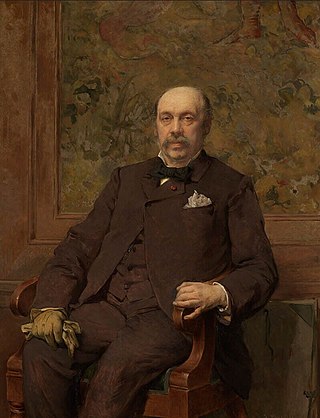
Jean-François Portaels or Jan Portaels was a Belgian painter of genre scenes, biblical stories, landscapes, portraits and orientalist subjects. He was also a teacher and director of the Academy of Fine Arts of Ghent and the Académie Royale des Beaux-Arts in Brussels. He is regarded as the founder of the Belgian Orientalist school. He was praised in his time as the premier painter of 'everyday elegance and feminine grace'. Through his art, teaching and his leadership of the Académie Royale in Brussels he exerted an important influence on the next generation of Belgian artists, including his pupil Théo van Rysselberghe.

François Pascal Simon Gérard, titled as Baron Gérard in 1809, was a prominent French painter. He was born in Rome, where his father occupied a post in the house of the French ambassador, and his mother was Italian. After he was made a baron of the Empire in 1809 by Emperor Napoleon, he was known formally as Baron Gérard.

Louis-Jean-François Lagrenée was a French rococo painter and student of Carle van Loo. He won the Grand Prix de Rome for painting in 1749 and was elected a member of the Académie royale de peinture et de sculpture in 1755. His younger brother Jean-Jacques Lagrenée was also a painter.
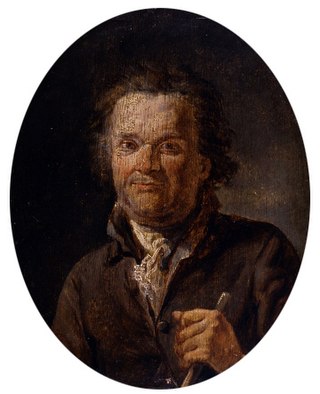
Jean-Antoine Constantin was a French painter.

Antoine-Sébastien Plamondon was an artist in Quebec, who painted mainly portraits and religious images, the latter commissioned primarily by churches in and around Quebec City. As a young man, he had traveled to France and studied painting in Paris for four years, with such portraitists as Jean-Baptiste Paulin Guérin.

Merry-Joseph Blondel was a French history painter of the Neoclassical school. He was a winner of the prestigious Prix de Rome in 1803. After the salon of 1824, he was bestowed with the rank of Knight in the order of the Legion d'Honneur by Charles X of France and offered a professorship at the École nationale supérieure des Beaux-Arts: a position in which he remained until his death in 1853. In 1832, he was elected to a seat at the Académie des Beaux-Arts in Paris.

Robert Jacques François Faust Lefèvre was a French painter of portraits, history paintings and religious paintings. He was heavily influenced by Jacques-Louis David and his style is reminiscent of the antique.

Louis Pierre Henriquel-Dupont was a French engraver. His students included Charles Bellay, Jean-Baptiste Danguin, Adrien Didier, Alphonse and Jules François, Adolphe-Joseph Huot, Achille and Jules Jaquet, Jules Gabriel Levasseur, Aristide Louis, Louis Marckl, Isidore-Joseph Rousseaux, Abel Mignon and Charles Albert Waltner.
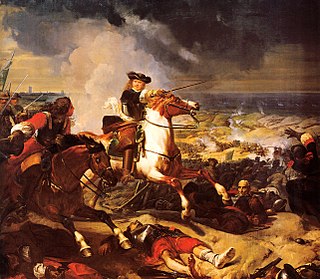
Charles-Philippe Larivière was a French academic painter and lithographer.
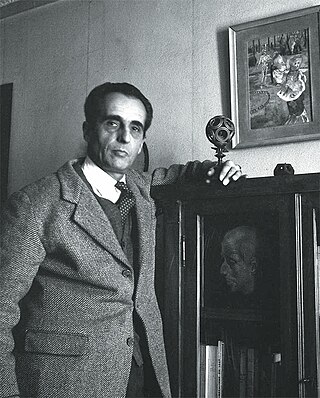
Jean-Claude Fourneau was a French painter close to the surrealist movement.

Joseph Vincent François Courdouan was a French painter who specialized in maritime scenes.
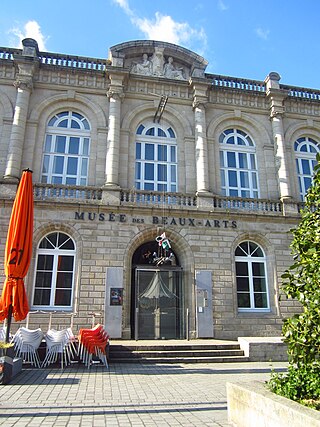
The Musée des Beaux-Arts de Quimper is an art museum located in Quimper, Brittany, France. It was founded after Jean-Marie de Silguy (1785-1864) left a legacy of 1200 paintings and 2000 drawings to the town of Quimper on condition that the town build a museum to accommodate them. Today, it is one of the principal art museums in western France, presenting rich collections of French, Italian, Flemish, and Dutch paintings from the 14th century to present day.
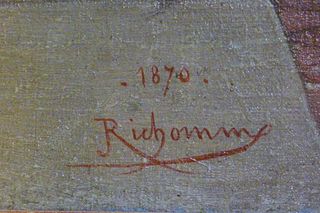
Jules Richomme was a French portrait, landscape, genre and history painter.

François Puget was a French painter in the Baroque style; known primarily for his portraits.